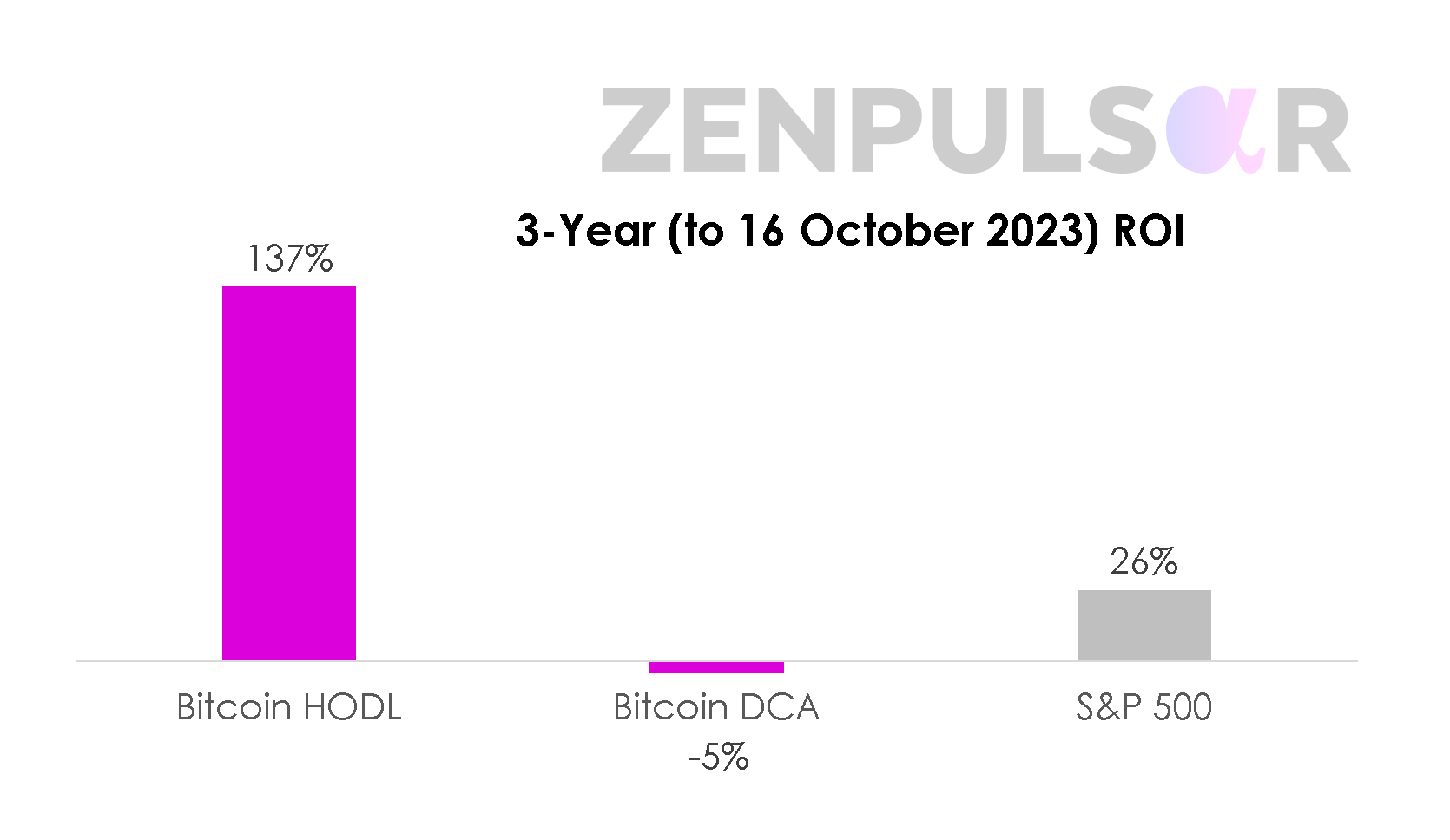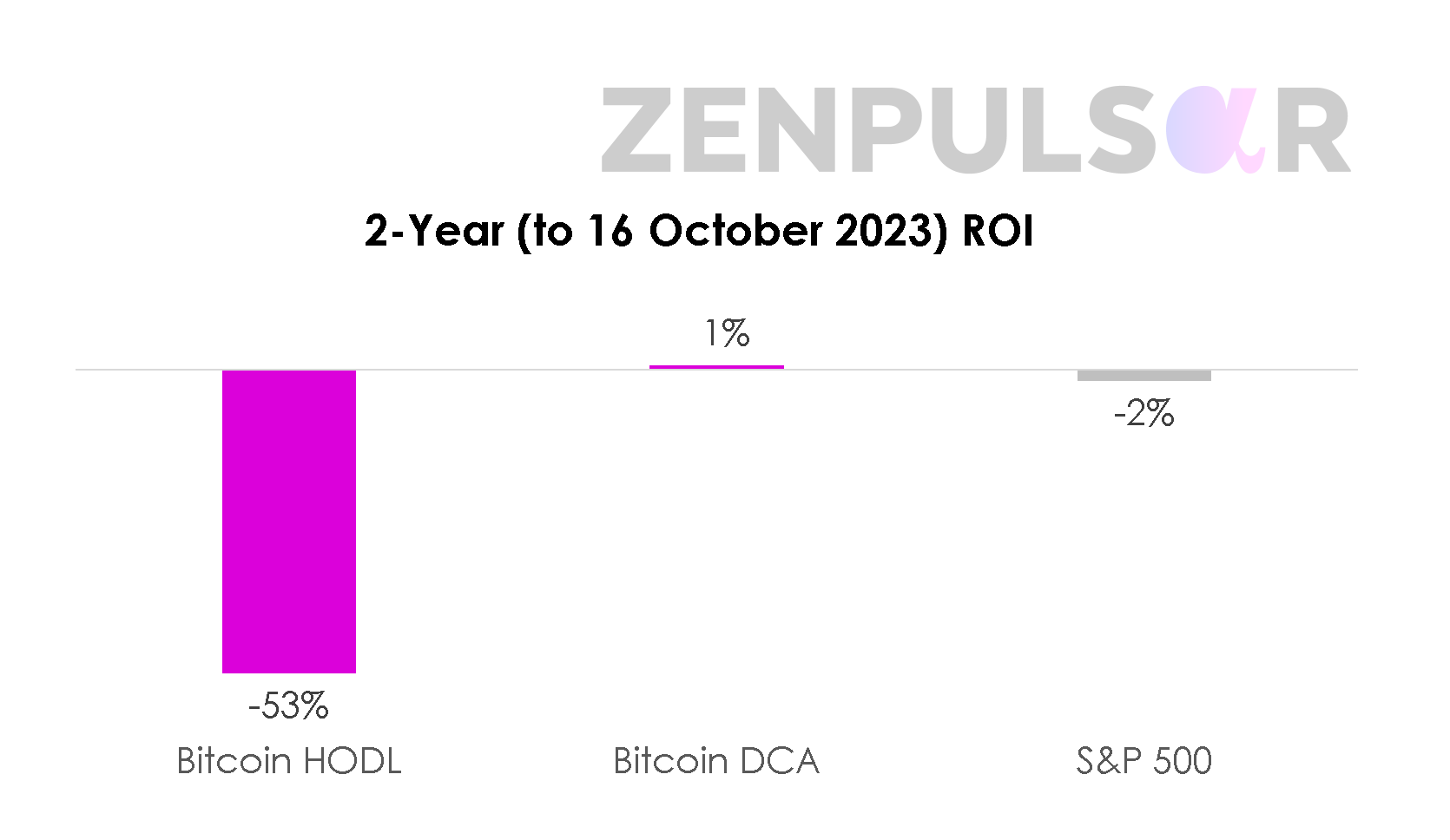HODL (Hold on for Dear Life) and DCA (Dollar Cost Averaging) are among the most popular conservative strategies used by crypto investors. Their simplicity and purported robustness in dealing with volatile markets have attracted millions of investors. While HODL is uncomplicated to the extreme, DCA requires a bit more legwork from an investor in terms of both administration and ROI assessment. The key question is whether these strategies even work when it comes to Bitcoin investment. We have analysed and simulated Bitcoin data for the past 3-year period to see if HODL and DCA are as “bullet-proof” as some proponents suggest. In this article, we detail the results of our analysis.
HODL and DCA in Crypto Market
Over the years, millions of investors joined the cryptocurrency market, attracted by its relatively low barriers of entry, flexibility, and 24/7 availability. Many of these investors quickly default to one of the two uncomplicated and long-term oriented investment strategies – HODL (Hold on for Dear Life) and DCA (Dollar Cost Averaging).
HODL is nauseatingly simple – it involves investing a certain amount in crypto and then holding on to your investment without any adjustments or knee-jerk reactions, even if the market crashes or enters periods of insane volatility. The idea is that over the long term, Bitcoin is likely to appreciate in value, delivering positive returns. The central idea of HODL is not to react to any shorter-term fluctuations and to hope for a positive ROI years down the line.
DCA also has a long-term focus but uses a different approach. Using the DCA strategy, you would buy Bitcoin at regular intervals, e.g., quarterly, monthly, weekly, or even daily, for the same fixed investment amount. Instead of ploughing all your money into the asset at once and HODLing it, you would split your investment across regular intervals.
For example, while a HODLer might invest $36,000 at once and hold it for three years, a DCA investor splits the same amount into 36 monthly intervals over the same three-year period and buys $1,000 worth of Bitcoin once a month. Over the total investment period of three years, the invested amount is the same - $36,000. However, a DCA investor splits it evenly over the entire period to smooth out any fluctuations and protect themselves from extreme or prolonged bear markets. DCA also aims to minimise the risk of investing a large lump sum during a market peak. This risk is always present in HODL investing.
Both HODL and DCA have their merits, and not only in the crypto market. The key reasons why they have become massively popular for Bitcoin and crypto investment are:
· HODL and DCA are simple strategies, which is an attractive feature for many crypto investors. The vast majority of these investors lack the resources or technical expertise required to employ the more complex strategies typically used by investment funds and other institutional investors.
· HODL and DCA are known as effective long-term strategies in many financial markets, especially those where volatility levels are high. HODLing and DCAing are two of the major ways of dealing with big market fluctuations. With the crypto market known for its high volatility, these strategies were bound to be popular among Bitcoin investors.
· Since the birth of active crypto trading in the early 2010s, the cryptocurrency market has largely moved upwards on a long-term basis. While shorter-term crashes and “crypto winters” come and go, the overall Bitcoin price chart over a period of multiple years keeps moving upwards. This makes HODL and DCA particularly attractive.
· HODL and DCA are passive investment strategies. You can employ them without having to continually analyse the market and dedicate time to rebalancing or adjusting your investment. Even DCAing on a daily basis can be easily automated.
With the popularity of HODL and DCA, comes the question of whether these seemingly bullet-proof strategies are successful for Bticoin investors. We have analysed Bitcoin data and simulated both HODL and DCA to answer this critical question.
Our Methodology
We have taken a look at 2 analysis periods for Bitcoin – the last 3 years and 2 years. Both HODL and DCA, and particularly the former, can be used for periods lasting from as little as a couple of years to many years. There are HODLers that stick to their investment for periods of 5 years or more. We wouldn’t be vastly off the mark if we suggested that there are thousands of Bitcoin investors who have held their investment intact for over a decade.
However, for an investor interested in eventually turning a profit, such extreme HODLing is hardly attractive. A period of about 3 years would be a reasonable long-term investment window, at least by the standards of the very dynamic crypto market, to expect profit from HODLing or DCAing.
Additionally, the use of the 2-year period in our analysis is also important to verify if HODL and DCA can be effective on a relatively shorter-term basis. A major reason why we have looked at the 2-year period is also due to the massive November 2021 crypto market crash. We noted above that Bitcoin has moved largely upwards on a multi-year basis. However, around two years ago, it crashed hard and hasn’t recovered to the levels of late 2021 as of today. Given these developments, HODL over a period of the last 3 years (or more) is guaranteed to show a positive ROI, but a shorter interval analysis would produce totally different results.
The Bitcoin data we analysed was sourced from the popular crypto portal Coingecko.com. Our analysis covers 3-year and 2-year periods to 16 October 2023. For the DCA analysis, we assumed daily investments. Many DCAers use weekly or monthly investment intervals. The use of weekly or monthly data for our analysis would produce very similar results to the daily data we have chosen. We decided on the use of daily data to measure DCA in the most precise and sensitive way.
Results – Bitcoin HODL and DCA
3 Years (mid-October 2020 to mid-October 2023)
A three-year investment period would be very typical for a crypto HODLer or DCAer who tries to balance the long-term adherence to these strategies with profit-seeking. We consider this to be the “main” analysis period out of the two time intervals we have looked at.
Three years ago, in mid-October 2020, Bitcoin was worth slightly less than $11,500. As of the time of writing, it trades at over $27,000. Obviously, 3-year Bitcoin HODLers have done very well by adhering to this simple strategy. What about DCAers? Their ROI results turned out to be much less impressive, as the chart below shows.

Following the Bitcoin DCA strategy between mid-October 2020 and mid-October 2023 has resulted in a negative ROI of -5%. In contrast, Bitcoin HODLing over the last 3 years has earned an investor following this strategy a handsome return of 137%.
We have also shown the ROI results for the S&P 500 index over the same period for comparison purposes. The 26% return for S&P 500 gives an idea about the typical ROI one would earn from investing in average risk/average performance stocks.
2 Years (mid-October 2021 to mid-October 2023)
Some hardcore HODLers might consider 2 years to be too short a period for this strategy. However, what actually constitutes a sufficient HODL period isn’t something set in stone. Many crypto investors use short-term investment periods. By the standards of the market, 2 years might be a sufficiently long HODL or DCA period for an investor whose ultimate motive is making profit.
Additionally, it was important to consider the 2-year period due to the massive crash of the crypto market in late 2021. Bitcoin prices haven’t recovered yet to pre-crash levels as of today. It’s easy to find HODL to be a profitable strategy if you only consider periods without significant market adversities like the 2021 crash.
The results of our analysis for the 2-year period were drastically different from the results for the longer, 3-year time interval, as shown below.

With the market not having recovered to the pre-late 2021 levels, Bitcoin HODLing in the last 2 years has resulted in a massively negative ROI of -53%. In contrast, following the DCA strategy has minimised the damage and resulted in a roughly breakeven situation (a 1% return). DCA’s result is particularly notable, as during the same period, S&P 500 experienced -2% negative growth.
Conclusion
The results of our analysis demonstrate that DCA, which is often viewed as an even more conservative investment strategy than HODL, has done a good job of minimising the damage during the lackluster Bitcoin market of the last 2 years. At the same time, DCA performed poorly, though not disastrously, over the last 3-year period.
This investment strategy is probably ill-suited to making a profit in a buoyant market. However, as our results prove, it provides the necessary damage control when the market is sluggish or negative.
HODL has done well on a 3-year basis but, as expected, resulted in significant losses over the last 2 years, when the crypto market’s performance paled in comparison to the pre-November 2021 levels. Over a very long time interval, i.e., many years, HODL is likely to deliver positive returns. However, this strategy is too inflexible due to the need to wait out many years to “guarantee” profits. The guaranteed profits might also never materialise if a generational market reversal occurs.
HODL is very reliant on a market not experiencing a very long-term reversal. Crypto HODLers have grown accustomed to Bitcoin growing in price over multi-year periods. Among diehard HODLers, the belief is that Bitcoin will, perhaps in a few years, come back to the levels of October 2021, when it soared above $60,000. Bitcoin currently struggles to reach $30,000 and might never come close to $60,000.
What happened in late 2021 might just be the early stage of a generational crypto market reversal. As such, Bitcoin HODLing in 2023 is a much riskier undertaking that Bitcoin HODLing in 2013.
DCA, on the other hand, might still be useful for some Bitcoin investors. This strategy, as our results show, isn’t a route to high ROIs. However, it does its job of minimising losses in a long-term Bitcoin bear market.

